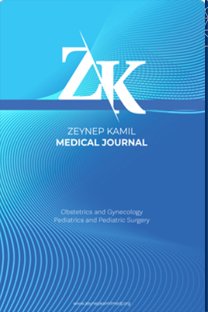The effect of embryo transfer technique on pregnancy and live birth rates in infertile women undergoing IVF treatment with freeze-all strategy
The effect of embryo transfer technique on pregnancy and live birth rates in infertile women undergoing IVF treatment with freeze-all strategy
___
- 1. Allahbadia GN, Kadam K, Gandhi G, Arora S, Valliappan JB, Joshi A, et al. Embryo transfer using the SureView catheter-beacon in the womb. Fertil Steril 2010;93:344–50.
- 2. McDonald JA, Norman RJ. A randomized controlled trial of a soft double lumen embryo transfer catheter versus a firm single lumen catheter: Sig- nificant improvements in pregnancy rates. Hum Reprod 2002;17:1502– 6.
- 3. Buckett WM. A review and meta-analysis of prospective trials comparing different catheters used for embryo transfer. Fertil Steril 2006;85:728– 34.
- 4. Brown J, Buckingham K, Buckett W, Abou-Setta AM. Ultrasound versus ‘clinical touch’ for catheter guidance during embryo transfer in women. Cochrane Database Syst Rev 2016;3:CD006107.
- 5. Tiras B, Polat M, Korucuoglu U, Zeyneloglu HB, Yarali H. Impact of em- bryo replacement depth on in vitro fertilization and embryo transfer out- comes. Fertil Steril 2010;94:1341–5.
- 6. Eskandar MA, Abou-Setta AM, El-Amin M, Almushait MA, Sobande AA. Removal of cervical mucus prior to embryo transfer improves pregnancy rates in women undergoing assisted reproduction. Reprod Biomed On- line 2007;14:308–13.
- 7. Moragianni VA, Cohen JD, Smith SE, Schinfeld JS, Somkuti SG, Lee A, et al. Effect of macroscopic or microscopic blood and mucus on the success rates of embryo transfers. Fertil Steril 2010;93:570–3.
- 8. Plowden TC, Hill MJ, Miles SM, Hoyt B, Yauger B, Segars JH, et al. Does the presence of blood in the catheter or the degree of difficulty of embryo transfer affect live birth? Reprod Sci 2017;24:726–30.
- 9. Schoolcraft WB. Importance of embryo transfer technique in maximizing assisted reproductive outcomes. Fertil Steril 2016;105:855–60.
- 10. Yao Z, Vansteelandt S, Van der Elst J, Coetsier T, Dhont M, De Sutter P. The efficacy of the embryo transfer catheter in IVF and ICSI is operator- dependent: A randomized clinical trial. Hum Reprod 2009;24:880–7.
- 11. Frydman R. Impact of embryo transfer techniques on implantation rates. J Gynecol Obstet Biol Reprod (Paris) [Article in French] 2004;33:S36–9.
- 12. Kava-Braverman A, Martínez F, Rodríguez I, Álvarez M, Barri PN, Coroleu B. What is a difficult transfer? Analysis of 7,714 embryo trans- fers: The impact of maneuvers during embryo transfers on pregnancy rate and a proposal of objective assessment. Fertil Steril 2017;107:657– 63.e1.
- 13. Arora P, Mishra V. Difficult embryo transfer: A systematic review. J Hum Reprod Sci 2018;11:229–35.
- 14. Tomás C, Tikkinen K, Tuomivaara L, Tapanainen JS, Martikainen H. The degree of difficulty of embryo transfer is an independent factor for pre- dicting pregnancy. Hum Reprod 2002;17:2632–5.
- 15. Spitzer D, Haidbauer R, Corn C, Stadler J, Wirleitner B, Zech NH. Ef- fects of embryo transfer quality on pregnancy and live birth delivery rates. J Assist Reprod Genet 2012;29:131–5.
- 16. Tur-Kaspa I, Yuval Y, Bider D, Levron J, Shulman A, Dor J. Difficult or repeated sequential embryo transfers do not adversely affect in vitro fertilization pregnancy rates or outcome. Hum Reprod 1998;13:2452–5.
- 17. Tıras B, Cenksoy PO. Practice of embryo transfer: Recommendations during and after. Semin Reprod Med 2014;32:291–6.
- 18. Practice Committee of the American Society for Reproductive Medicine. Electronic address: ASRM@asrm.org; Practice Committee of the Ameri- can Society for Reproductive Medicine. Performing the embryo transfer: A guideline. Fertil Steril 2017;107:882–96.
- 19. Brown J, Buckingham K, Buckett W, Abou-Setta AM. Ultrasound versus ‘clinical touch’ for catheter guidance during embryo transfer in women. Cochrane Database Syst Rev 2016;3:CD006107.
- 20. Cozzolino M, Vitagliano A, Di Giovanni MV, Laganà AS, Vitale SG, Bla- ganje M, et al. Ultrasound-guided embryo transfer: Summary of the ev- idence and new perspectives. A systematic review and meta-analysis. Reprod Biomed Online 2018;36:524–42.
- 21. Lambers MJ, Dogan E, Lens JW, Schats R, Hompes PG. The position of transferred air bubbles after embryo transfer is related to pregnancy rate. Fertil Steril 2007;88:68–73.
- 22. Baba K, Ishihara O, Hayashi N, Saitoh M, Taya J, Kinoshita K. Where does the embryo implant after embryo transfer in humans? Fertil Steril 2000;73:123–5.
- 23. Aichberger L, Boldizsar A, Herczeg C, Obermair A, Plöckinger B, Strohmer H, et al. Vaginal ultrasonographic observation of uterine con- tractions in embryo transfer and its relevance to treatment success. Ge- burtshilfe Frauenheilkd 1991;51:27–30.
- ISSN: 1300-7971
- Yayın Aralığı: Yılda 4 Sayı
- Yayıncı: Ali Cangül
Ayça ÖZGÜREL BOZKURT, Nazan USAL TARHAN, Enis ÖZKAYA
Nihan UYGUR KÜLCÜ, Züleyha Aysu SAY, Habibe AYVACI TAŞAN, Handan ÇETİNER, Zeynep Gamze KILIÇOĞLU
Surgical treatment of the rectal prolapse in children: A review
Cengiz GÜL, Sabri CANSARAN, Ayşenur CELAYİR
Evaluation of voiding functions with the micturition video: The preliminary results
Tuğçe Merve ORBAY, Ayşenur CELAYİR, Cengiz GÜL, Bekir ERDEVE
Serkan ORAL, Alper ŞİŞMANOĞLU, Yaşam Kemal AKPAK, Sebahattin ÇELİK, Nazan YURTÇU
Fetal megacystis at 11–14 weeks of gestation: 3-year experience of a tertiary center
Gökhan BOLLUK, Özge ÖZDEMİR, Burak DEMİRDELEN
Kutlay GÜR, Nihan UYGUR KÜLCÜ, Özlem ERDEDE, Erdal SARI, Rabia Gönül SEZER YAMANEL, Abdulkadir BOZAYKUT
Evaluation of the relationship between dental caries and urinary tract infections
Fedli Emre KILIÇ, Habip ALMİŞ, İbrahim Hakan BUCAK, Mehmet TURGUT
Effect of COVID-19 on anesthesia preferences in cesarean section: An observational study
Meryem ONAY, Sema ŞANAL BAŞ, Ümit AKKEMİK, Ayten BİLİR
Serum follistatin-like-3 levels in the diagnosis of tubal ectopic pregnancy
Işıl AYHAN, Ahter Tanay TAYYAR, İsmail DAĞ, Melike ALTINTAŞ, Hakan BİLGESOY, Betül YILMAZER
